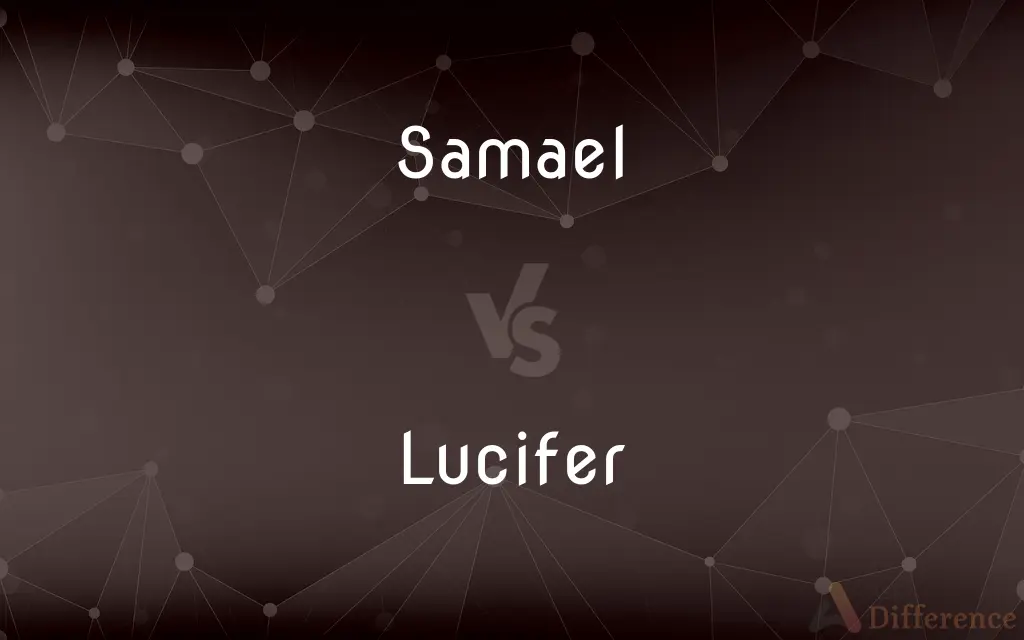Samael vs. Lucifer — What's the Difference?
By Tayyaba Rehman — Updated on November 7, 2023
Samael is often seen as an accuser, seducer, and destroyer, equated with the Angel of Death, while Lucifer is traditionally identified as the Devil, the personification of evil and rebellion against God.

Difference Between Samael and Lucifer
Table of Contents
ADVERTISEMENT
Key Differences
Samael and Lucifer are two distinct figures in religious texts with nuanced differences. Samael, sometimes identified in Judaism as an angel of death, is known for his role in tempting humans and as a figure of judgement. In contrast, Lucifer, rooted in Christian theology, is synonymous with the fallen angel narrative, representing pride and rebellion. Both figures are often associated with adversarial roles in their respective religious contexts, yet their origins and symbolisms differ. Samael's existence is tied to the balance of good and evil, acting as an executor of divine will, whereas Lucifer's story is that of a fall from grace, embodying the ultimate rebellion against the divine order.
In the lore surrounding these entities, Samael is depicted as a complex character with duties that serve God's will, even when appearing malevolent. Lucifer's depiction is more straightforward, as a symbol of pure defiance and evil. Samael's relationship with humanity is ambiguous, sometimes seen as a punisher and at other times as a purifier, while Lucifer is consistently portrayed as seeking to lead humanity astray. Both are often conflated with the concept of Satan, but their roles and representations remain distinct within theological discussions.
The distinction between Samael and Lucifer can be observed in their mythological roles. Samael is a figure who operates within the divine system, albeit in a harsh manner, whereas Lucifer is often seen as a tragic figure who sought to overthrow the divine hierarchy. Samael's actions, though sometimes destructive, are considered necessary for the maintenance of the cosmic balance. Lucifer, on the other hand, is a rebel who sought to elevate himself above his station, resulting in his fall and subsequent role as an antagonist to God's creation.
Despite their different roles, both Samael and Lucifer serve as important archetypes in the discussion of good and evil. Samael represents the necessary evil that exists within the framework of the divine, executing judgments that are difficult but essential. Lucifer represents the pitfalls of pride and ambition, reminding believers of the consequences of turning away from divine will. Each serves to illustrate the complexities of morality and the consequences of one's actions within the framework of their respective religious narratives.
In summary, Samael and Lucifer are two distinct figures in theistic traditions, each with their unique attributes and narratives. Samael is associated with the harsher aspects of divine judgment and the balance between good and evil, while Lucifer is emblematic of pride, rebellion, and the fall from divine grace. While sometimes these figures are conflated with the broader concept of Satan, they retain their unique identities and roles within religious mythology, serving as symbols and warnings within the moral and spiritual discourse.
ADVERTISEMENT
Comparison Chart
Origin of Name
Hebrew for "Venom of God"
Latin for "Light-bringer"
Role in Texts
Angel of death, accuser
Fallen angel, devil
Symbolism
Divine justice and destruction
Pride and rebellion
Mythological Status
Ambiguous, both revered and feared
Universally considered as evil
Representation
Often a grim character executing divine will
Often depicted as a charismatic deceiver
Compare with Definitions
Samael
Samael is often depicted as a warrior angel, embodying the wrath of God.
With a sword of fire, Samael struck down the enemies of the divine as a fierce protector.
Lucifer
Lucifer signifies the 'morning star', a metaphor for the rise and fall of pride.
Like Lucifer, he was a rising star in the company, only to fall from grace due to his arrogance.
Samael
Samael can represent the severity of divine judgement in mystical traditions.
In his hands, Samael held the scales of justice, measuring the souls of mortals.
Lucifer
Lucifer can represent enlightenment and knowledge, paradoxically linked to his fall.
Seeking knowledge beyond his reach, he reached a Luciferian ambition that led to disaster.
Samael
Samael is sometimes seen as a prosecutor in the heavenly court.
It was said that Samael would present the sins of the deceased with unwavering zeal.
Lucifer
Lucifer is commonly known as the name for the Devil before his fall in Christian tradition.
Lucifer was once the brightest angel before pride led to his downfall.
Samael
Samael is a figure in Jewish mythology associated with the Angel of Death.
In the tales, Samael approached the gates of the Garden of Eden with a sly grin.
Lucifer
Lucifer is a symbol of temptation and the seduction of power.
The allure of unchecked power was a Luciferian temptation he could not resist.
Samael
Samael is occasionally equated with Satan, although they have distinct roles.
Samael, unlike Satan, did not rebel against God but served as a divine agent.
Lucifer
Lucifer is the name of various figures in folklore associated with the planet Venus. Originally stemming from a son of the personified dawn, the goddess Aurora, in Roman mythology, the entity's name was subsequently absorbed into Christian folklore as a name for Satan.
Samael
Samael (Hebrew: סַמָּאֵל, Sammāʾēl, 'Venom of God, Poison of God' or 'Blindness of God, Left Hand of God'; Arabic: سمسمائيل, Samsama'il or سمائل, Samail; alternatively Smal, Smil, Samil, or Samiel) is an archangel in Talmudic and post-Talmudic lore; a figure who is the accuser (Ha-Satan), seducer, and destroyer (Mashhit). Although many of his functions resemble the Christian notion of Satan, to the point of being sometimes identified as a fallen angel,: 257–60 in others he is not necessarily evil, since his functions are also regarded as resulting in good, such as destroying sinners.He is considered in Talmudic texts to be a member of the heavenly host with often grim and destructive duties.
Lucifer
(Bible) An angelic being who was cast from heaven as punishment for his rebellious pride. Lucifer is traditionally identified with Satan.
Lucifer
The planet Venus in its appearance as the morning star. Also called Phosphorus.
Lucifer
Lucifer A friction match.
Lucifer
A self-igniting match, ie. one which could be lit by striking on any surface (as opposed to safety matches which only light against the material on the side of the box).
Lucifer
The planet Venus, when appearing as the morning star; - applied in Isaiah by a metaphor to a king of Babylon.
How art thou fallen from heaven, O Lucifer, son of the morning! how art thou cut down to the ground which didst weaken the nations!
Tertullian and Gregory the Great understood this passage of Isaiah in reference to the fall of Satan; in consequence of which the name Lucifer has since been applied to Satan.
Lucifer
Hence, Satan.
How wretchedIs that poor man that hangs on princes' favors! . . . When he falls, he falls like Lucifer,Never to hope again.
Lucifer
A match{1} made of a sliver of wood tipped with a combustible substance, and ignited by friction; - called also lucifer match, and locofoco, now most commonly referred to as a friction match. See Locofoco.
Lucifer
A genus of free-swimming macruran Crustacea, having a slender body and long appendages.
Lucifer
(Judeo-Christian and Islamic religions) chief spirit of evil and adversary of God; tempter of mankind; master of Hell
Lucifer
Lighter consisting of a thin piece of wood or cardboard tipped with combustible chemical; ignites with friction;
He always carries matches to light his pipe
Lucifer
Lucifer is often used to depict the ultimate rebel against divine authority.
His defiance against the established norms was likened to Lucifer challenging the heavens.
Common Curiosities
Who is Samael?
Samael is often identified in Jewish tradition as an angel of death and an accuser.
Are Samael and Lucifer the same entity?
No, they are different figures with distinct roles in their respective religious mythologies.
Who is Lucifer?
Lucifer is traditionally known in Christian theology as a fallen angel and the personification of rebellion against God.
What does the name Lucifer mean?
Lucifer means "Light-bringer" or "Morning Star" in Latin.
Is Lucifer considered evil?
Yes, Lucifer is typically associated with evil and is depicted as the Devil in Christianity.
Does Samael have a role in the fall of humanity?
Samael is sometimes associated with temptation, but his role varies across texts.
Can Samael be considered a divine agent?
In some traditions, Samael acts as an executor of God's will, despite his severe methods.
What does the name Samael mean?
Samael is Hebrew for "Venom of God" or "Poison of God".
Is Samael considered evil?
Samael's role is complex; he is sometimes viewed as malevolent, but also as fulfilling a necessary divine function.
Is Lucifer ever seen in a positive light?
Rarely in traditional theology, though some modern interpretations view him as a symbol of human striving and rebellion against tyranny.
What is the significance of Samael in religious scripture?
Samael serves to illustrate the harsh realities of divine judgement and the balance of good and evil.
What is Lucifer's role in the fall of humanity?
Lucifer is often blamed for tempting Eve in the Garden of Eden, leading to the fall of humanity.
Are there different interpretations of Samael?
Yes, interpretations of Samael vary widely across different Jewish mystical texts.
What is the significance of Lucifer in religious scripture?
Lucifer embodies the consequences of pride and rebellion against divine authority.
Are there different interpretations of Lucifer?
Lucifer's image has evolved over time, but he is consistently seen as a figure of evil in Christian thought.
Share Your Discovery

Previous Comparison
Understand vs. Realize
Next Comparison
Spamming vs. FlamingAuthor Spotlight
Written by
Tayyaba RehmanTayyaba Rehman is a distinguished writer, currently serving as a primary contributor to askdifference.com. As a researcher in semantics and etymology, Tayyaba's passion for the complexity of languages and their distinctions has found a perfect home on the platform. Tayyaba delves into the intricacies of language, distinguishing between commonly confused words and phrases, thereby providing clarity for readers worldwide.















































